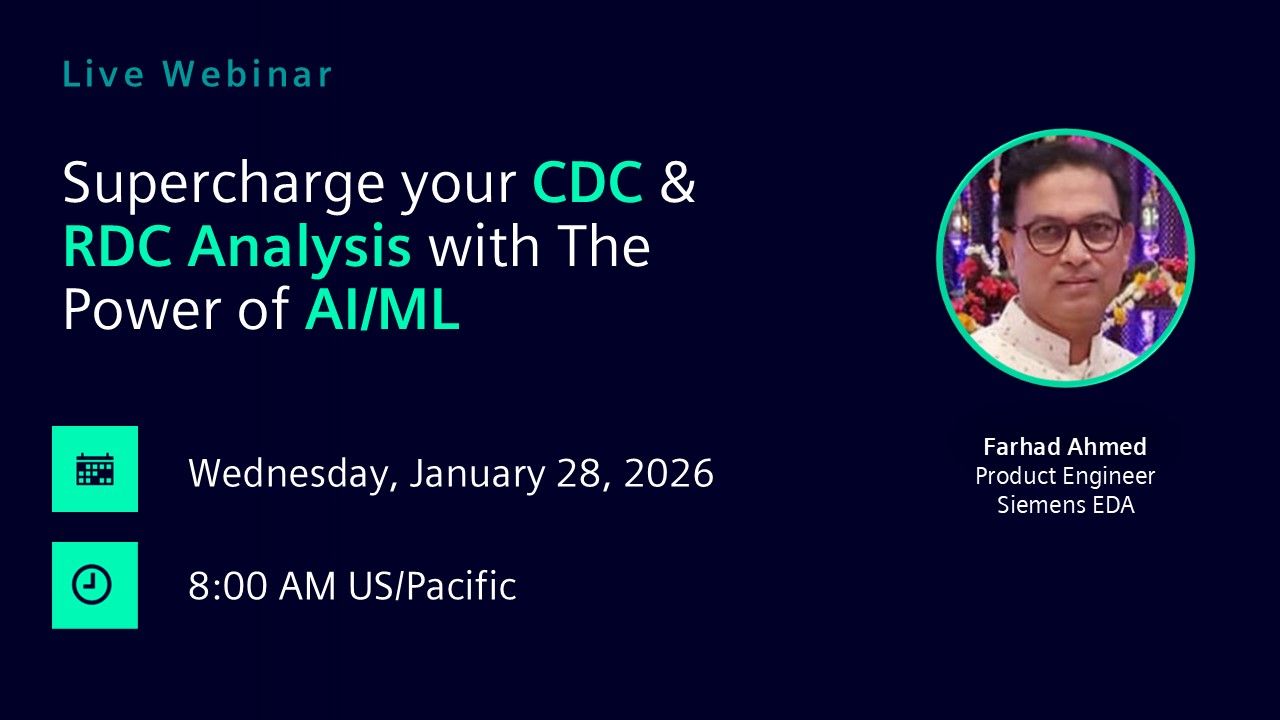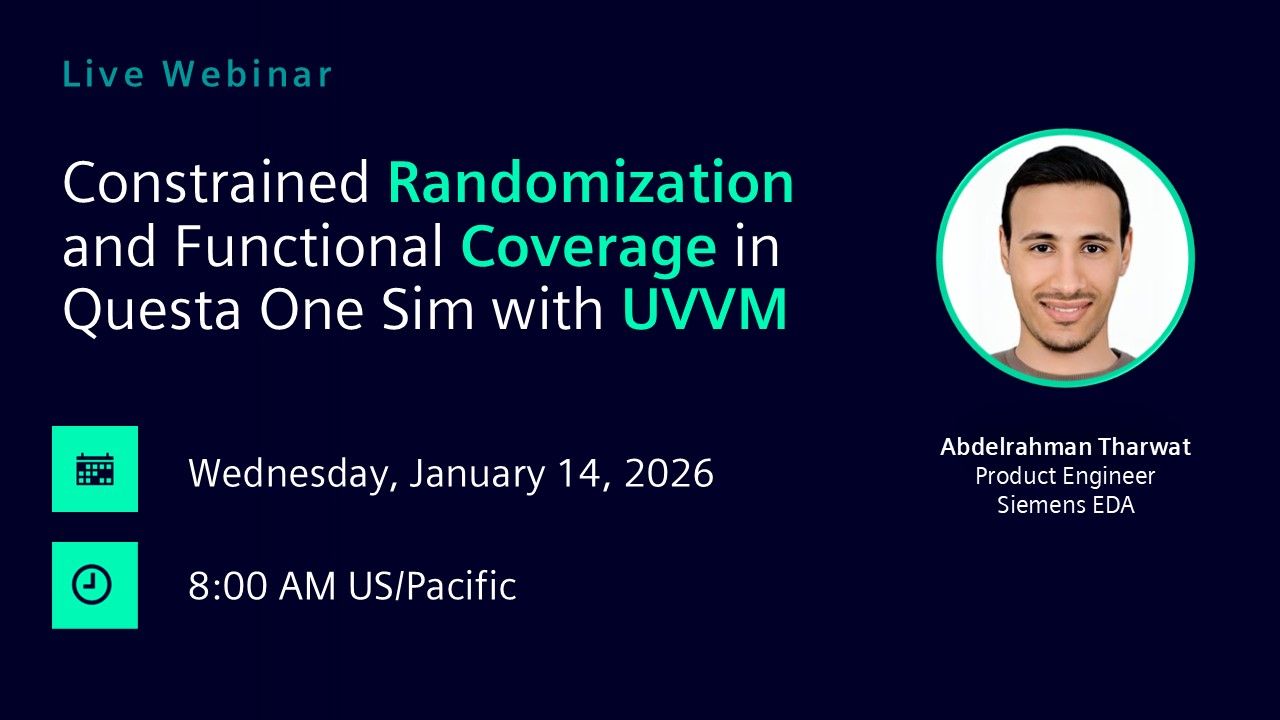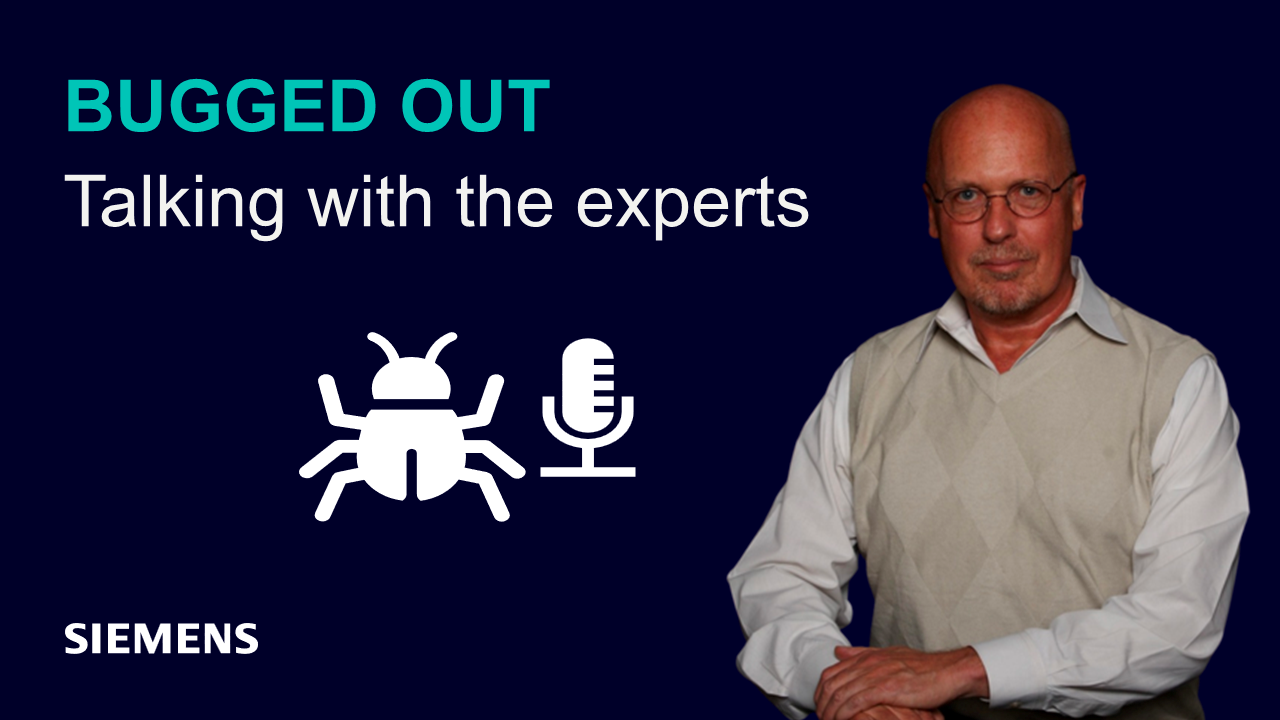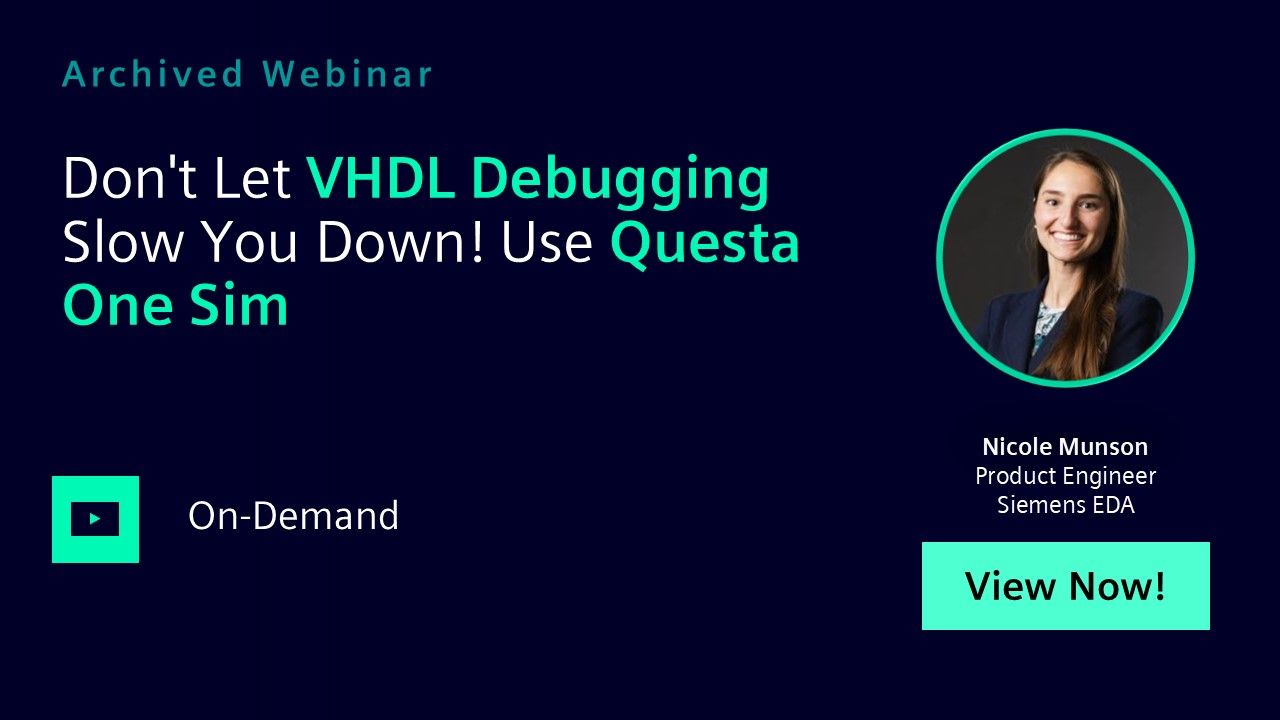Search Results
Filters
Advanced Search
2175 Results
-
Verification Academy Live in Silicon Valley - Avery Verification IP for AI/ML/HPC
Seminar - Feb 04, 2026 by Joe Hupcey
Join Siemens' Verification IP experts, customers & partners. Benefit from deep dives & lively panel debate. Discuss AI/ML interface standard Landscape, and how RTL verification teams are leveraging Avery next-gen Verification IP, Compliance Test Suites & Software-Aware Verification IP flows to verify high-performance protocol designs for 3DICs & SoCs. Wednesday, February 4, 2026 | 9:30 AM - 3:30 PM Location Siemens EDA 5455 Great America Pkwy - 5th floor conference center Santa Clara, CA 95054
-

Supercharge your CDC & RDC Analysis with The Power of AI/ML
Webinar - Jan 28, 2026 by Farhad Ahmed
One of the biggest challenges in CDC/RDC verification is managing the complexity and time-consuming nature of identifying and resolving violations. CDC/RDC Assist addresses this challenge by leveraging AI/ML to automate and accelerate causality analysis. In this webinar, you will learn how to streamline CDC/RDC verification using machine learning to automate violation detection and resolution.
-

Constrained Randomization and Functional Coverage in Questa One Sim with UVVM
Webinar - Jan 14, 2026 by Abdelrahman Tharwat
In this webinar, we’re excited to showcase the latest cutting-edge features of Questa One Sim, with UVVM (Universal VHDL Verification Methodology) . Learn how the newly added support for constrained randomization with multi-variable capabilities allows you to dynamically generate randomized, UVVM-compliant stimuli that address even the most intricate design constraints, helping you explore vast verification scenarios efficiently and effectively.
-

BUGGED OUT Podcast
Podcast - Dec 16, 2025 by Harry Foster
Every chip has bugs — the real question is how fast you can find and fix them. BUGGED OUT is the bite-sized podcast where we shine a light on the art (and science) of functional verification.
-
The Future of Semiconductors: Engineering in the Convergence Era
Resource (Paper (.PDF)) - Dec 09, 2025 by Harry Foster
The semiconductor industry is entering a convergence era where silicon, software, physics, packaging, security, AI, and power constraints all intertwine. Device scaling still matters but architecture, integration, verification, and automation will define the industry’s trajectory. Organizations that embrace this cross-domain, lifecycle-oriented mindset will define the next decade.
-

The Future of Semiconductors: Engineering in the Convergence Era
Paper - Dec 09, 2025 by Harry Foster
Reflections from inside an industry undergoing its biggest transformation in decades. The semiconductor industry is entering a convergence era where silicon, software, physics, packaging, security, AI, and power constraints all intertwine. Device scaling still matters but architecture, integration, verification, and automation will define the industry’s trajectory. Organizations that embrace this cross-domain, lifecycle-oriented mindset will define the next decade.
-
FutureCast 2026: A Special Holiday Edition of BUGGED OUT
Resource (Verification Horizons Blog) - Dec 09, 2025 by Harry Foster
As another year closes, the semiconductor industry finds itself in a moment of transition—one where the pace of innovation is accelerating faster than many expected. Chip architectures are evolving, system boundaries are shifting, and verification continues expanding into new territory we couldn’t have imagined even a decade ago. And like many of you, I find the end of the year to be a natural time to pause, look back, and ask a simple but important question: Where is all of this heading?
-

Aerospace & Defense
Reference - Dec 03, 2025 by Todd Holbrook
Welcome to the Aerospace and Defense event archive, where you will find presentations and slide decks from live events that you may have missed. *Please note: you will need a valid login to download the session presentations.
-
Questa One Smart Verification: Unleashing the Potential of AI Within Functional Verification
Resource (Slides (.PDF)) - Dec 03, 2025 by Austin Mam
Leverage the power of AI and ML Smart Verification revolutionizes functional verification by using faster engines that complement traditional heuristics with machine learning. Allow engineers to be more productive with advanced creation, analysis, and debugging capabilities, while reducing workloads through predictive technologies that streamline and accelerate the verification process.
-
Introducing Questa One SFV: The Transformation of Static & Formal Powered by AI/ML
Resource (Slides (.PDF)) - Dec 03, 2025 by David Landoll
In today's fast-paced development schedules, engineers are constantly balancing innovation with efficiency. Questa One SFV, powered by AI/ML, is designed to streamline workflows, eliminate steep learning curves, and accelerate adoption. Learn how SFV can integrate into your current flow and improve productivity.
-
Ensure High Quality RTL with Early Continuous Integration
Resource (Slides (.PDF)) - Dec 03, 2025 by Walter Gude
Learn the value of Continuous Integration (CI) during development and how Questa Design Solutions are ideally suited for implementation in CI flows. Discover the benefits of integrating CI early to enhance RTL quality and streamline development processes.
-
Enhancing Verification Productivity with Questa One
Resource (Slides (.PDF)) - Dec 03, 2025 by Sunil Sahoo
Improving productivity has become crucial for efficiently utilizing expensive human and grid resources in the functional verification process. Achieving the "done" state requires more than simulator performance— it demands a strategic focus on optimizing workflows, prioritizing tasks, and leveraging metrics to guide efforts. Questa One Sim's productivity-driven approach ensures resources are deployed effectively, accelerating verification closure.
-
VA Live - Scottsdale: Introduction and Welcome
Resource (Slides (.PDF)) - Dec 03, 2025 by Todd Holbrook
Welcome to Verification Academy Live.
-

Debug Like a Pro: VHDL Testbenches with OSVVM, UVVM, & UVM in Questa One Sim
Webinar - Dec 03, 2025 by Mariam Maurice
This webinar explores the debugging capabilities and best practices across the three leading VHDL verification (OSVVM, UVVM, UVM) frameworks.
-
Debug Like a Pro: VHDL Testbenches with OSVVM, UVVM, & UVM in Questa One Sim
Resource (Slides (.PDF)) - Dec 03, 2025 by Mariam Maurice
This webinar explores the debugging capabilities and best practices across these three leading VHDL verification frameworks.
-
Accelerating Coverage Closure in FPGA Verification: Metric-Driven Verification Leveraging Questa CoverCheck
Resource (Slides (.PDF)) - Nov 19, 2025 by Ajay Bhaskaran - L3Harris
In this session, you will learn how FPGAs have evolved to match ASIC-level complexity, there is a dire need for deploying metric-driven verification to ensure comprehensive verification with the need for “accelerated” coverage closure. We share key challenges, and deployment steps from implementing Questa CoverCheck for automated Code coverage analysis and improvement, highlighting measurable gains in verification execution efficiency with tangible results.
-
Questa One Avery Verification IP: Delivering Accelerated Confidence
Resource (Slides (.PDF)) - Nov 19, 2025 by Luis Rodriguez
In this session, you will learn how Questa One Avery VIP’s cutting-edge technologies promise to enhance productivity and ease of use in the rapidly expanding landscape of complex interfaces and memory protocols, spanning SoC designs, 3DIC chiplets, and FW/SW integration.
-
Enhancing Verification Productivity with Questa One Sim
Resource (Slides (.PDF)) - Nov 19, 2025 by Sunil Sahoo
In this session, you will learn how Questa One Sim’s productivity-driven approach ensures resources are deployed effectively, accelerating verification closure.
-
System Testbench with Questa Parallelsim
Resource (Slides (.PDF)) - Nov 19, 2025 by John Liu - Northrop Grumman
In this session, you will learn how Questa ParallelSim processing significantly improves test efficiency and performance in a complex multichip FPGA system.
-

MARLUG - 2025
Seminar - Nov 19, 2025 by Sunil Sahoo
User2User Mid-Atlantic is your opportunity to learn, grow and connect with fellow technical experts who design leading-edge electronics products using Siemens EDA tools.
-

Don't Let VHDL Debugging Slow You Down! Use Questa One Sim
Webinar - Nov 12, 2025 by Nicole Munson
In this webinar, you will learn how Questa One Sim empowers VHDL designers to dramatically enhance their debugging productivity. We'll move beyond basic simulation viewing and dive into advanced features designed to pinpoint issues faster, understand design behavior more intuitively, and streamline your entire VHDL RTL debug workflow.
-
Don't Let VHDL Debugging Slow You Down! Use Questa One Sim
Resource (Slides (.PDF)) - Nov 12, 2025 by Nicole Munson
In this webinar, you will learn how Questa One Sim empowers VHDL designers to dramatically enhance their debugging productivity.
-
Introducing BUGGED OUT — A new bite-sized podcast for verification engineers
Resource (Verification Horizons Blog) - Nov 10, 2025 by Harry Foster
I’m excited to share something I’ve been working on for a while — my new podcast, BUGGED OUT . If you’ve been in verification long enough, you know the truth: Every chip has bugs. The real challenge — and the real creativity — is in how we find and fix them quickly. This podcast is about that work. Each episode is 10–15 minutes, designed for a commute, a coffee break, or that moment when your simulation farm is spinning and you finally have a minute to think.
-

HLV: Formal Verification of Synthesizable C++/SystemC Designs
Webinar - Nov 05, 2025 by Vlada Kalinic
Formal check tools are difficult to be analyzed on generated RTL (as the errors cannot be correlated to HLS source code) Catapult Formal/Onespin SystemC help to overcome this challenge. Under HLV there are several apps, to verify and clean C++ HLS code before running HL Synthesis and then apply equivalency between C++ and RTL to guarantee that golden C++ is equivalent with final RTL design.
-
HLV: Formal Verification of Synthesizable C++/SystemC Designs
Resource (Slides (.PDF)) - Nov 05, 2025 by Vlada Kalinic
Under HLV there are several apps, to verify and clean C++ HLS code before running HL Synthesis and then apply equivalency between C++ and RTL to guarantee that golden C++ is equivalent with final RTL design.
